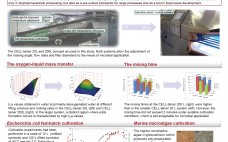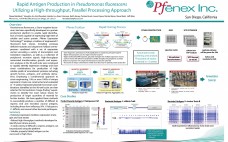Implementation of postlicensure process improvements in the biopharmaceutical industry can benefit patients and drug manufacturers alike. Here we demonstrate through a case study how a change to the cell culture medium and process can be taken from proof of concept through scale-up to demonstration of feasibility. We further illustrate the scope and complexity of implementing a change in commercial manufacturing to realize significant benefits such as increased production capacity over an existing legacy process. The Importance of Postapproval Improvements Drug…
Upstream Processing
Enhancing Antibody Production
Increasing demand for monoclonal antibodies (MAbs) — useful as immunodiagnostic reagents in basic research applications and potential immunotherapeutics — has created a need to optimize protein production techniques. Many developers have attempted to increase MAb output from cell culture by addressing both equipment and consumables. For example, recent advances in improved bioreactor designs and bioreactor operation have increased antibody outputs by increasing cell densities and extending cell life in culture. Materials and Methods () Bioreactors can operate in batch, perfusion,…
Microbial Cultivation In Different Scales in the CELL-tainer® Rocking Single-use Bioreactor
Single-use bioreactors are applied in the biopharmaceutical industry for mammalian cell culture processes. The low gas-liquid mass transfer coefficient generally achieved in these systems does not allow for the compatable application of microbial processes in these bioreactor systems. The CELL-tainer® technology combines a vertical and horizontal movement in a rocking bioreactor concept, so that the turbulence and power input is intensified. In this system, mass transfer rates comparable to stirred tank reactors are achievable. Thus, volumetric oxygen transfer rates (kLa)…
A Systematic Strategy of Cell Culture Media and Feed Development
Development of a high-performance and robust fed-batch process for recombinant Chinese Hamster Ovary (CHO) cell lines presents challenges in light of the diverse nutritional requirements observed with different clonally derived cell lines as well as the varied production phases. To address these challenges, we will discuss an innovative strategy of media, feed, and process development that has been developed at FUJIFILM Diosynth Biotechnologies (FDB). The efficiency and effectiveness of this strategy have been well demonstrated in multiple mAb-producing CHO cell…
Continuous Bioprocessing: A CMO’s Perspective
The maturation of many process industries is marked by transition from batch to continuous processing. Often this move to con-tinuous processing determines the winners in the industry. Will the bioprocess industry go the same way? The analogy is often drawn to the chemical industry where continuous processing is widely applied. Although available for many decades continuous bioprocessing is not yet a mainstay of the industry. Currently there is a ground swell of feeling within the bioprocess industry that the time…
Rapid Antigen Production in Pseudomonas fluorescens Utilizing a High-throughput, Parallel Processing Approach
Pseudomonas fluorescens, a Gram-negative bacterium, has been specifically developed as a protein production platform to enable rapid identification of strains capable of expressing high titers of soluble and active protein. PfÄ“nex Expression Technology (TM) employs a toolbox of engineered P. fluorescens host strains, including protease deficient mutants and chaperone/ foldase overexpressors combined with a set of expression vectors encoding a variety of transcription and translation regulators, as well as a collection of periplasmic secretion signals. High-throughput automated transformation, growth, and…
Emerging Challenges to Protein A
Protein A affinity chromatography has been a target for replacement since its commercial debut, mainly because of its high acquisition cost. The technique became established despite the cost because it was born into an industrial culture that favored speed to market over manufacturing economy (1). Vendors have since strengthened protein A’s position with incremental but worthy improvements such as higher capacity, lower ligand leaching, and modest tolerance of NaOH. Collateral improvements in polishing technologies, such as the high throughput and…
Virus Risk Mitigation for Raw Materials
Recombinant protein–based medicinal products and modern cell-based vaccines have a very strong safety history with respect to viral and microbial contamination. However, virus contamination incidents do occur occasionally in manufacturing processes, and they can consume many resources and be expensive to rectify. The root cause of contamination incidents in recent years is most likely the use of contaminated raw materials. These include bovine serum contaminated with reovirus, epizootic hemorrhagic disease virus, Cache valley virus or vesivirus 2117; porcine trypsin contaminated…
Development Strategies for Novel Vaccines for Infectious Diseases
In a vaccine development program, the probability of success at each transition decreases, even though the actual probability of moving from one phase to another can be 50–80% (Figure 1). Many compounds and vaccine candidates are screened out even before they get into preclinical studies. Developers can implement different approaches to reduce product failure risk before a program gets expensive, including Establishing a product development plan (PDP) Identifying and mitigating risk with gap analysis Learning from the mistakes of others…
Development of Protein Capsular Matrix Vaccine Platform Technology
Polysaccharide vaccines account for about 30% of the total >$20-billion/year vaccine market. Despite efficacious vaccines in the field, diseases such as invasive Streptococcus pneumoniae and typhoid fever persist. Development of multivalent polysaccharide conjugate vaccines requires complex chemistries and multiple, expensive good manufacturing practice (GMP) process steps. Matrivax Research and Development Corporation is developing a protein capsular matrix vaccine (PCMV) technology that simplifies synthesis of polysaccharide vaccines with fewer process steps than are required by typical conjugation vaccine processes. Polysaccharide Vaccine…




